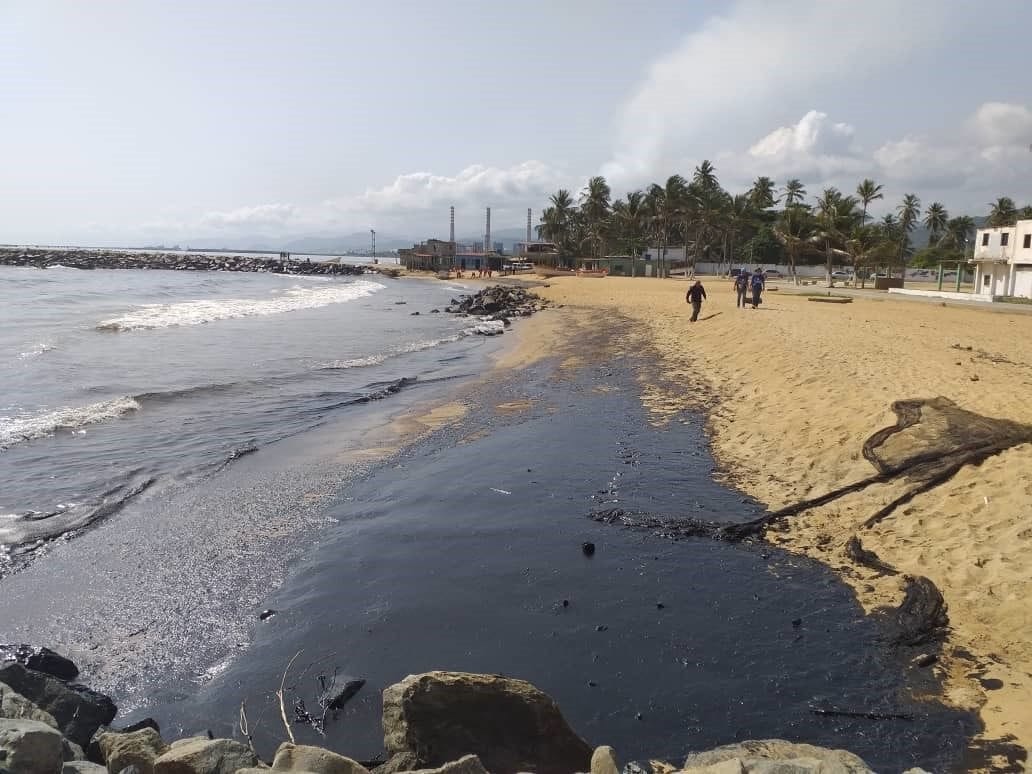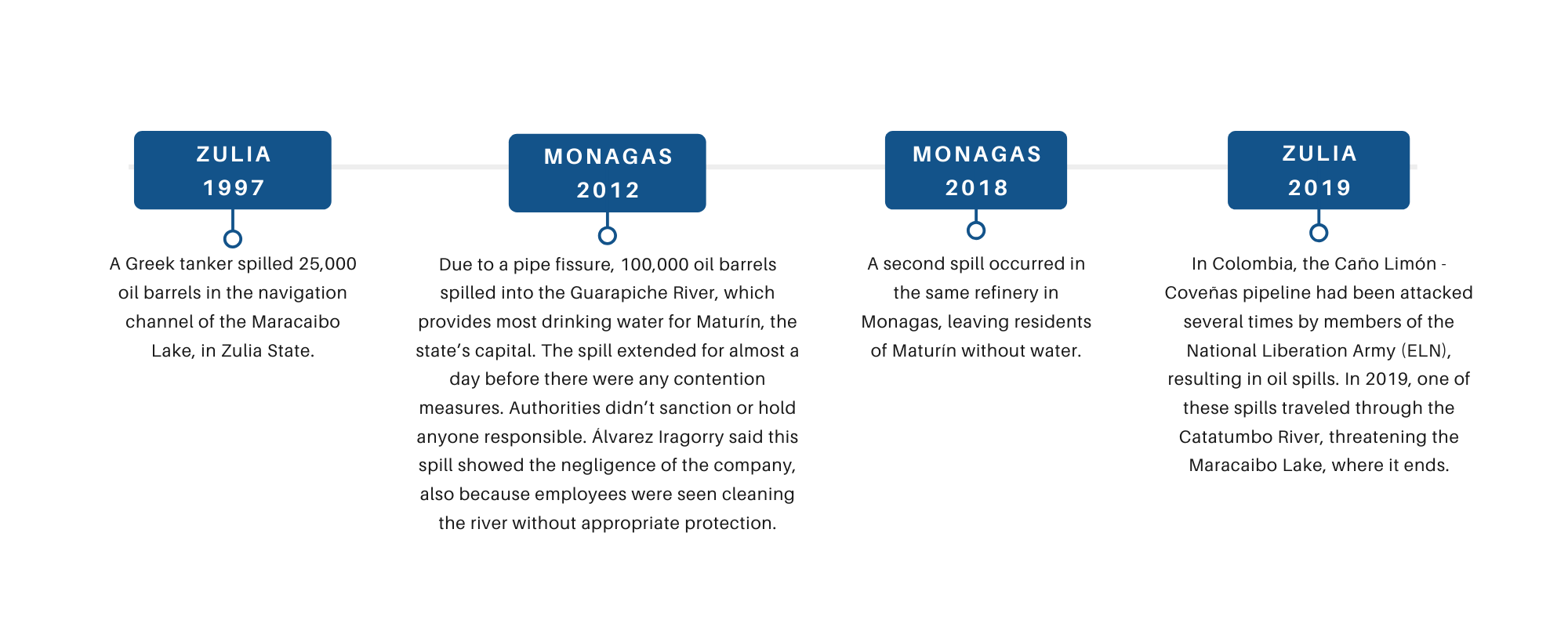PDVSA Turns a Blind Eye to Oil Spills in Venezuela
As PDVSA remains silent about the oil spill in El Palito, experts struggle to assess the damages to the Venezuelan coasts


The spill is potentially catastrophic.
Photo: Sociedad de Ecología
Images of oil staining the beaches of northwestern Venezuela flooded social media recently. They show a dark substance covering the sand in one of the country’s most popular national parks: Morrocoy, in Falcón State.
The spill originated at the El Palito refinery, located in Puerto Cabello, Carabobo State, according to Dr. Eduardo Klein from Simón Bolívar University (USB). Using satellite images, he calculated that the spill occurred between July 19th and 22nd, and that approximately 20,000 barrels spilled. Their contents expanded across 55 km of length and an area of 68 square km (equivalent to 34 miles of length and 26.3 square miles).
Dr. Klein explained during an interview with BBC Mundo that the spill spread west until it reached the coast of Morrocoy, which is known for its clear waters and mangroves that house entire ecosystems. The spill has hence taken over the region known as the Triste Gulf, but what caused it remains undetermined.
El Palito is controlled by Venezuela’s state-owned oil company, PDVSA. As of August 20th, the company hasn’t publicly addressed the spill, so experts aren’t able to determine the causes or magnitude. Therefore, they can’t determine the consequences nor appropriate mitigation measures.
Multiple organizations have denounced the company’s silence, including the National Assembly and the Venezuelan Society of Ecology (SVE), a group of environmental scientists, researchers and academics.
Deputy María Gabriela Hernández, president of the AN’s commission for the environment, has also denounced that the president of the National Parks Institute (Inparques) has threatened its workers so they don’t share information.
Dip.@MariaGMonagas: “La afectación de Cayo Borracho es seria. El Presidente de Imparques ha estado desmeritando el derrame y amenza a sus trabajadores para que no den información “. Es considerado el ferre marítimo más grande en los últimos 2 años. #RégimenEcocida pic.twitter.com/QGHUC57oKZ
— Asamblea Nacional (@AsambleaVE) August 19, 2020
The AN commission also warned about the potential collapse of a tanker close to the Paria Gulf, in Sucre State, eastern Venezuela. The ship is reportedly carrying 3.1 million barrels of oil and the commission fears it can damage the environment if its collapse isn’t prevented.
The Physical, Mathematical and Natural Sciences Academy (ACFIMAN) and the Engineering and Habitat Academy (ANIH) said in a statement on August 20th that PDVSA started paying attention to the spill 22 days after it happened, on August 9th: “The procedures that the company implemented showed the precariousness of the equipment and personnel with scarce training and knowledge to respond to the magnitude of the damaged caused… The delayed and precarious response of PDVSA and the Ministry of Environment, the MINEC, and the silence of the prosecutor’s office and ombudsman demonstrate again the level of deinstitutionalization of the country.”
During a forum held on August 18th, Vilisa Morón Zambrano, president of the SVE, and Alejandro Álvarez Iragorry, coordinator at NGO Clima21, said that because PDVSA is the company in charge of the refinery, it must report the causes, magnitude and characteristics of the spill, as well as what (if any) contingency plans are in place.
Morón Zambrano added that, by August 17th, the substance was no longer visible on the surface of the water. But that doesn’t mean the danger is gone. It’s unknown whether the stain was collected or spread towards the bottom of the sea. The Caribe Sur Foundation pointed out that the spill can still affect living creatures, including people.
Que ya no se vea petróleo flotando en el agua, no significa que no siga allí. Los efectos de un #derrame son persistentes en el tiempo y afectan a todos los seres vivos, incluyéndonos. pic.twitter.com/5lB15vjZHl
— Fundación Caribe Sur (@CaribeSurOrg) August 19, 2020
Dr. Klein’s models showed that the spill remained close to the refinery for about a week. But, it wasn’t until the first week of August that the Fundación Azul de Ambientalistas noticed and warned about it.
“What happened in those days? Nobody knows,” Álvarez Iragorry said during the forum. “PDVSA should’ve informed and started a contingency plan that’s usually activated immediately with contention bars, which are like floaters made of fabric that absorb the oil and prevent the stain from advancing. Then, it’s collected with pumps.”
What’s also unknown is the exact type of hydrocarbon that was spilled, as Álvarez Iragorry and Morón Zambrano explained. This makes it hard to assess the impact that the spill has on the environment and the local community because the toxicity of the substance isn’t known.
Still, Clima21 published a report saying that the spill began to affect the mangroves in Morrocoy around August 8th and 9th. Álvarez Iragorry told Caracas Chronicles that the substance could stick to the mangroves, possibly asphyxiating them to the point where animals and other organisms lose their home.
Biologist and member of the SVE Julia Álvarez Barco said that the spill can have short, medium and long term effects on the environment. It could even affect Morrocoy for 50 years.
Julia Álvarez Barco, bióloga: “Aun no tenemos la información técnica del derrame, ni del hidrocarburo ni del tipo de componente del hidrocarburo. Este derrame puede tener efectos negativos a corto, mediano y largo plazo”. #RégimenEcocida pic.twitter.com/XfDrlXNLdc
— Asamblea Nacional (@AsambleaVE) August 19, 2020
Plus, Morón Zambrano explained during the forum on August 18th that the spill can affect the health and economy of the local community, by affecting the fish of the area. She insisted that determining the impact (and the appropriate mitigation measures) requires measuring the quantity and toxicity of the spilled material through a robust scientific evaluation.
Waiting for Answers
According to the SVE and Clima21, locals, volunteers and NGOs are cleaning some beaches. Employees of Inparques have also been present, and the Ministry of Ecosocialism has published on social media that they’ve installed contention bars in Morrocoy.
Álvarez Iragorry added that the ministry and volunteers have helped collect stained sand, but there aren’t scientific reports about how much has been cleaned. These contention methods are also superficial so he, along with members of the SVE, insist that a scientific evaluation is needed to know how much of the spill has been cleaned.
With PDVSA’s silence, scientists are left making hypotheses about the causes. Álvarez Iragorry told Caracas Chronicles that, given how El Palito has had multiple small accidents before, it was expected that something in the refinery would lead to a spill like this one. Also, the lack of maintenance of the place—which he said even former PDVSA workers have denounced—can be a factor.
He said that former PDVSA workers mentioned the possibility that the material comes from the refinery’s waste pit, which gathers multiple materials after oil is processed. These materials are supposed to be processed later. If they aren’t, they build up and may overflow.

What caused the spill is, at the time of writing, unknown.
Photo: Sociedad de Ecología
This remains a speculation, but Álvarez Iragorry said that it’s a likely cause. The pit is close to the coast and, when it’s full, “something as simple as rain can make it overflow.” The lack of maintenance doesn’t help.
The likelihood of this hypothesis is one reason why Álvarez Iragorry rules out that the spilled substance is crude. But, it’s also the fact that the material is coming from a refinery, not a pipe, and that the images from the beaches show a translucent, thick material. He compared it to the dark and thin-looking material seen in Mauritius island.
Why the distinction matters: Crude oil could have less damaging effects to people and the environment because it’s less dense. Plus, any material coming from the refinery could have toxic characteristics.
A Poor Record
The recent spill in El Palito isn’t the first one, and it’s not expected to be the last. Human rights NGO Provea found that, from 2010 to 2016, PDVSA was responsible for 46,820 spills of crude and other contaminating substances, “with a total of 856,722.85 barrels of crude spilled”. According to the organization, 30,674 of those spills affected bodies of water, the flora and fauna of the area, and the local economy.
Furthermore, Clima21 stated in its report that the Ecologist Association for the Environmental Preservation of Falcón State (AEPA Falcón) has documented 237 oil spills in the last 12 years from the refineries of Cardón and Amuay.
Álvarez Iragorry pointed out that, for any oil company, a spill means a loss of money—losing material that could be sold, needing resources to clean, and possibly receiving sanctions for the damage caused. When accidents occur, companies tend to monitor what went wrong and improve their protection procedures. This isn’t what PDVSA seems to be doing, and it isn’t the first time it acts that way.
Then, in 2017, a spill that originated in Trinidad affected the Gulf of Paria in eastern Venezuela. It reached Margarita and Los Roques—two other popular traveling destinations—and Bonaire, a Dutch island off the coast of Venezuela. While the spill started in Trinidad, it became the responsibility of the Venezuelan government to assess and contain the damage as soon as it reached the nation’s waters.
In these and other incidents, the lack of information and of effective contingency plans alerted experts about the decay of PDVSA. Álvarez Iragorry said the company was never perfect, but it used to have prestige. In the last ten years or so, he has seen the company’s standards lower, in part due to a loss of personnel (chavismo fired 20,000 employees after a strike in 2002-2003), and in part because of politicization inside the institution.
He also highlighted that what’s happening in Falcón and Carabobo doesn’t end in this incident.
“This must be answered by the same oil industry, which is a risk industry that can generate problems and damages, but it’s supposed to be improving and creating contingency plans to reduce the number of accidents,” he said. “Since this is not done well, the risk is higher every time.”
For all Venezuelans, he added, a priority should be to maintain the security of these risk industries, particularly oil. Even amid the economic and humanitarian crisis of the country, if the oil industry isn’t attended to, it can cause worse accidents to the environment and population.
Caracas Chronicles is 100% reader-supported.
We’ve been able to hang on for 22 years in one of the craziest media landscapes in the world. We’ve seen different media outlets in Venezuela (and abroad) closing shop, something we’re looking to avoid at all costs. Your collaboration goes a long way in helping us weather the storm.
Donate





